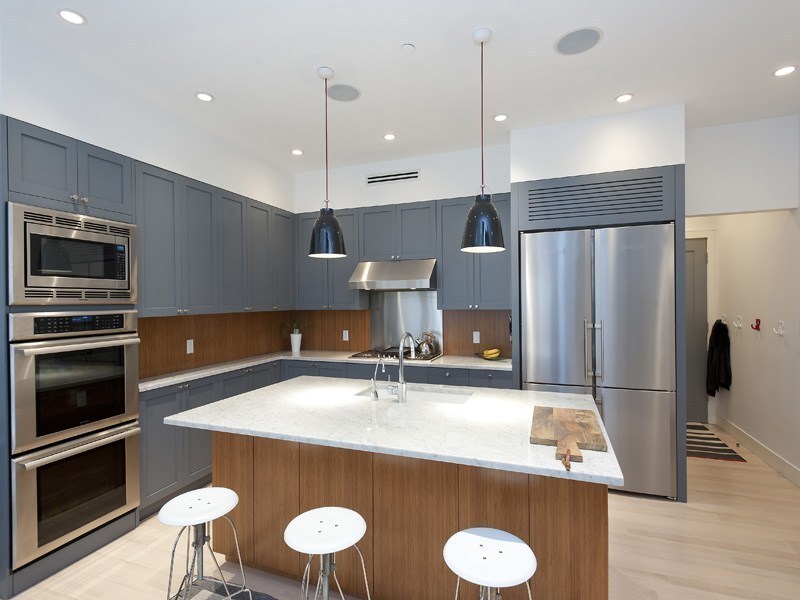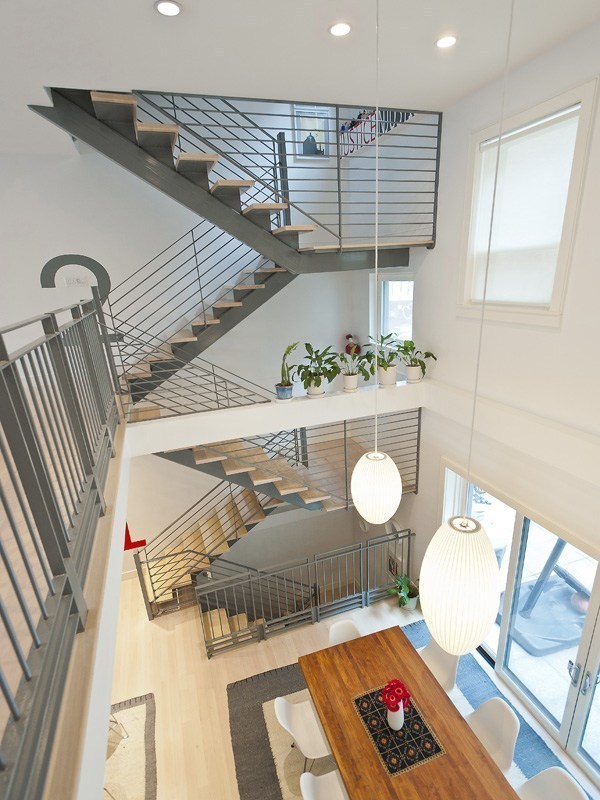

 Over the course of three years, we purchased two attached vacant lots in downtown Brooklyn. These lots were abnormally small, not even meeting the zoning requirements, but they were vacant. An Architect’s dream is to build your designs. The majority of the projects in New York are renovations as there is very little vacant land, and the lots that are available has issues.
Over the course of three years, we purchased two attached vacant lots in downtown Brooklyn. These lots were abnormally small, not even meeting the zoning requirements, but they were vacant. An Architect’s dream is to build your designs. The majority of the projects in New York are renovations as there is very little vacant land, and the lots that are available has issues.
The two lots that were purchased were 20′ x 60′. In the design, the two houses were mirrored as to keep the front doors spaced far apart. The chases for the plumbing, mechanical and electrical run up the party wall, allowing for a buffer between the two buildings. Trying to create privacy on these very small lots was the first approach in design.
Renovation in New York is very common and the process can be challenging, but new construction is very difficult. This project was filed with the Brooklyn Building Department in Summer 2009. The new building code was just approved. It was the first time since 1968 that New York City had adopted a new building code. The new building code had many changes to new single family residences. It required sprinklers throughout new construction of single family residences. It also required the compliance of the New York State Energy Code (NYSEC). These two items were the biggest changes that I needed to incorporate in the design. The requirement of sprinklers triggered other requirements with the Department of Environmental Protection (DEP). The sprinklers could be fed off the domestic water line that supplies your drinking water, but a backflow preventor must be provided so that the water entering the spinklers does not flow back into the drinking water. This required hydraulic calculations, and sizing, along with filing additional drawings and paperwork with the DEP. These drawings were reviewed and all the calculations needed to be verified with the DEP engineer.
The New York State Energy Code was a very complicated document that required many areas to be verified in compliance for approval. These areas included: windows and glazing area, energy loss through glazing, heat gain through glazing, mechanical equipment efficiencies, duct leakage, sealant, insulation types and rating, insulation and R-values of all materials in wall sections, and roofing section. Our buildings were very energy efficient and exceeded the requirements. The calculations and drawings were reviewed by a energy code plans examiner at the Building Department.
The set of drawings that are submitted to the building department, contain Zoning, Architectural, Sprinkler, Plumbing, Electrical, Structural, Excavation and Notes. This set was reviewed numerous times by the plans examiner at the building department along with the building department inspectors that would visit the construction site during the various stages of construction. A set of objections is provided to us after each reviews of the plans examiners. This list of objections notes the code section and what we will need to correct for each objection. This is similar to a draft and a marked-up review of a book. The drawings are copyrighted and are my intellectual designs.
Once the drawings were approved by the various agencies, construction began. Bouratoglou Architect, PC (which I am the Architect and 51% owner and my husband is 49%), we were the owners, Architect, and also acted as the General Contractor. In New York City, Architects is they provide the correct insurances, may also pull permits for construction. We hired and oversaw the construction of these two houses. I documented the construction through a blog, that showed the beginning process of design, to the final project. This project has been used in many classes and acts as a base for any construction related project we are working on. I was awarded a Fellowship Leave to continue to develop this blog into a publication. (I did not accept the fellowship as our department was in a time of transition in the curriculum.
Building Department Drawings: BOERUM PLACE
Reviews included:
New York City Building Department: For New Buildings, and Sidewalk and Pavement Improvements
New York City Department of Environmental Protection – For: Backflow Protector, Water Service, Sewer Connections
New York City Parks Department: As all new construction are required to provide new street trees
New York City Department of Transportation: For Sidewalk review and Construction Fence approval
Client Review: One of the buildings was sold during construction and changes and materials needed to be reviewed by clients. They also inspected the project weekly for quality of workmanship.
Bank Approval: Since this project was financed there was an inspector that came to the site after each phase was completed to review compliance with the approved drawings
New York City Excavation Unit: Before construction and during the foundation construction, the Excavation Engineers reviewed the drawings and made site visits to verify that all safety measures were being made for the adjacent buildings. (Hand digging was done next to one of the buildings to ensure the safety of the old foundation.)
Brownstoner: This website follows the construction within Brooklyn and there were numerous articles about the progress of the construction.



